I’ve experimented to find out the perfect way and amount of time to brine pork chops. You’re going to love this pork brine recipe and method because it always gives such juicy and delicious results.
Pork chops can often turn out dry and flavorless, but two things can improve their taste and texture: (1) Not overcooking them (pork should be slightly pink in the middle, at about 145°F), and (2) Using a wet brine to infuse salt, flavor, and moisture. I’ve done a series of tests to find out the best brine mixture for pork, as well as the amount of time to brine pork chops of different thicknesses for.
Additional details about this process are below, or you can click here to jump straight down to the recipe.
- What is Brining?
- What Goes In A Pork Chop Brine?
- What Kind Of Pork Chops To Brine
- How Long Should I Brine Pork Chops?
- How Long For Thin Pork Chops
- How To Brine Pork Chops
- How To Cook Brined Pork Chops
- Can You Freeze Brined Pork Chops?
- More Brining Recipes
- Podcast Episode: Brining Pork Chops
- How to Brine Pork Chops Recipe
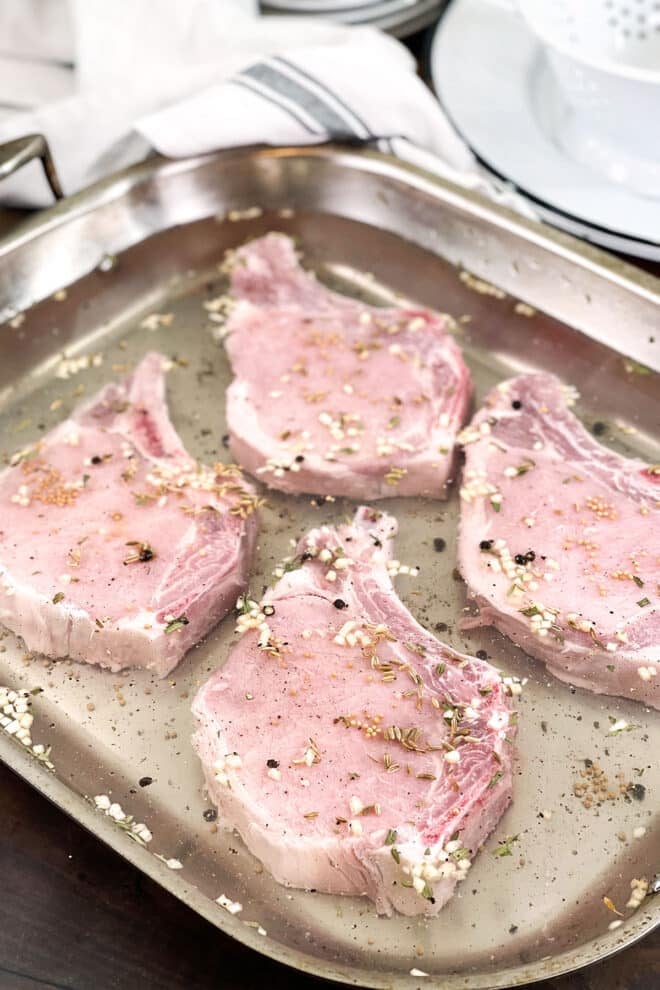
What is Brining?
Brining is the process of soaking meats in a salt water solution before cooking. Why would you need to do that? There’s a few reasons actually.
The meat soaks up the salt water which results in meat with more moisture, even after cooking. The salt also changes the texture of the meat, making it more tender. In addition, that salt is adding seasoning and flavor for a more delicious dish. For more information about brining, head over here.
So, if you want a juicier, more tender, and flavorful pork chop, brining is the perfect place to start.
What Goes In A Pork Chop Brine?
All that is really needed for a brine is salt and water. Sometimes additional seasonings or sugar are added as well. I used a standard brine recipe for testing, which yields enough brine to cover eight 1-inch thick pork chops.
The standard brine recipe is: 4 cups of cold water and 6 tablespoons Diamond Crystal kosher salt OR 4 1/2 tablespoons Morton’s kosher salt OR 3 tablespoons fine or table salt.
Please note that it actually matters what kind of salt you have and how much you use. The salt crystals in these above-listed types are all of different sizes. If you use the incorrect type or amount, you will end up with a brine that is either way too salty or not salty enough.
It’s also important that you use cold tap water. I did a series of tests brining chicken breasts to find out what works best. It turns out that water temperature is one of the things that matters. Cold tap water has a better effect than warm water. Hot water would begin to cook the meat and so it should be avoided.
To make your pork chop brine, all you need to do is mix together the salt and the water. It’s a large amount of salt though so it can take a minute or two for it to dissolve. Just stir it together and keep stirring until it’s less cloudy and there’s no more salt undissolved at the bottom.
Some people like to add optional ingredients for flavor such as peppercorns, crushed garlic, rosemary, whole cloves, or other herbs and spices. I don’t think it’s necessary for pork chops though. And, in fact, given the short amount of time that the chops need to be in the brine for, those flavors don’t really penetrate, and so I don’t bother. You can, however, add additional seasonings to your pork chops after brining them, just before cooking if you’d like. Just remember that you won’t want to season with additional salt.
What Kind Of Pork Chops To Brine
Remember I said that I did all that testing to get perfectly brined chicken breasts? I got some good experience back then testing the different times and water temperatures, flavorings, and more. I therefore wanted to follow-up and use my expertise to do that same experiment and find the perfect amount of time for pork chops too.
As with chicken, lean lighter colored meat turns out to be the best for brining. That’s because it has less flavor, making the added salt that much more welcome. The light meat also contains less fat and marbling, and it therefore benefits form the tenderizing. Just as I don’t typically recommend that you bother to brine chicken thighs, I don’t recommend that you bother to brine darker pork chop cuts, like shoulder chops.
From my testing, the best pork chops to brine are the center-cut rib chops, ideally 1-inch thick. These chops are made up of lean loin meat attached to a rib bone. That lean meat and the thickness really lets the brining effect shine.
How Long Should I Brine Pork Chops?
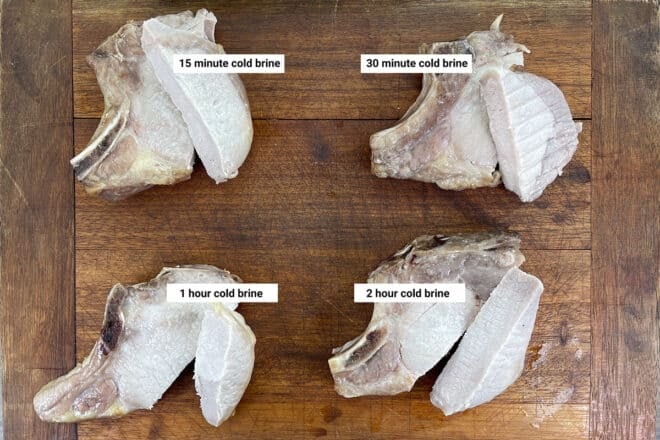
I did the bulk of my testing using those center-cut bone-in pork chops that were 1-inch thick. Note that in addition to the 1-inch thick chops, I also tested some thinner chops, which I’ll tell you about below.
I tested the 1-inch pork chops in the salt brine for 15 minutes, 30 minutes, 1 hour, 2 hours, 4 hours, and 8 hours. Here are the results: The 15 and 30-minute brined pork chops were well-seasoned on the outside, but their texture was still tough after being cooked. The 4-hour and 8-hour brines were unbearably salty and the meat was overly soft. I don’t recommend that unless you reduce the amount of salt used in the brine.
The best brining times for the one-inch thick chops is therefore between one and two hours. This amount of time gave the chops enough seasoning and a tender texture, even in the very middle of the chop where it tends to be driest. And, importantly, it wasn’t so long that the chops got too salty.
Chart: Pork Chop Texture And Flavor Results From Brine*
| BRINING TIME | RESULTS |
| 15 minutes | Lightly seasoned, no detectable change in texture. |
| 30 minutes | Lightly seasoned, no detectable change in texture |
| 1 hour | Perfectly seasoned, juicy, tender, noticeable difference in texture and tenderness. |
| 2 hours | Perfectly seasoned, juicy, tender, noticeable difference in texture and tenderness. |
| 4 hours | This is too salty, and the texture is like deli turkey or deli chicken. |
| 8 hours | This is too salty, and the texture was surprisingly dry. |
*As mentioned, the brining solution I use is my basic brine recipe, with cold tap water.
How Long For Thin Pork Chops
I have to say that my favorite pork chops are those bone-in, one-inch thick ones in the pictures above. However, I do sometimes buy the thinner cut chops, especially when they’re on sale.
The thinner chops are usually boneless loin chops, although sometimes they do have some bone. These chops are at most 1/2 of an inch thick.
As you might expect, thinner chops benefited from a shorter brining time – anywhere from 30 minutes, up to an hour. Any shorter and they remained tough, any longer and they became too salty.
How To Brine Pork Chops
To make the best brined pork chops, start by mixing the standard brine in a medium container large enough to hold all of your chops. Add the pork chops to the brine, then cover and let this stand for one hour.
It’s perfectly safe to have the cold brine and chops on the counter for 1 hour. Any longer wouldn’t be safe. If you want to refrigerate the pork chops while they’re brining, that’s fine too. Either way, set a timer for 60 minutes because you don’t want them in the brine for much longer than that, two hours is the maximum.
How To Cook Brined Pork Chops
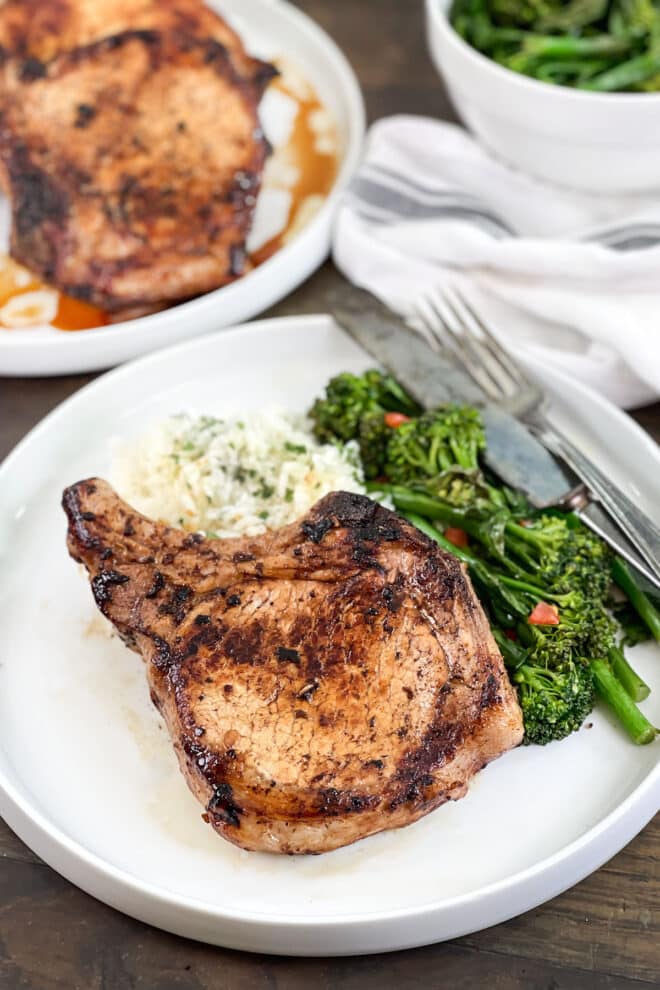
After the chops have brined for an hour, or two hours if you prefer, they can be grilled, pan-fried, baked, or braised according to your favorite recipe.
It’s important to note that the brine will not save an overcooked chop, so using a digital thermometer to closely monitor the temperature of the chop is helpful. Stop the cooking process when the chops reach an internal temperature of 140°F and then let them rest for five minutes. The carryover cooking will bring them to 145°F.
A little note about the temperature though. Many of us grew up at a time when pork needed to be cooked to 160F to be safe. We are therefore used to well-done pork meat that is not at all pink. However, in recent years, the guidelines for cooking pork have changed. It’s now considered safe to consume pork that has reached a minimum of 145F. Pork at 145F will be a bit pink in the middle. Even though it’s safe if cooked to this temperature, many people who were used to the more well-cooked pork don’t like to see that pinkness. If this is you, you might want to cook your pork a bit more. I then recommend that you cook it to 150F and let it rest to 155F, or even cook it to 155F and let it rest to 160F.
Can You Freeze Brined Pork Chops?
If you’re not ready to cook them after brining, the chops can be removed from the brine and kept in the refrigerator, covered, for up to three days, or wrapped well and stored in the freezer for up to two months. Do not freeze or refrigerate the pork chops in the brine. This will make them too salt, and the ice crystals will damage the meat.
More Brining Recipes
If you love how brining your pork chops worked out, you should try brining some other things. Here are some of my favorite brine recipes:
Podcast Episode: Brining Pork Chops
Listen to learn how to make this recipe, along with some great tips from Christine, by clicking the play button below:
Listen to more Recipe of the Day episodes here.
Print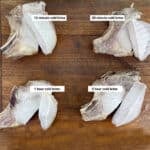
How to Brine Pork Chops Recipe
- Prep Time: 1 hour 10 minutes
- Total Time: 1 hour 10 minutes
- Yield: 8 pork chops 1x
- Category: Entrée
- Method: Brine
- Cuisine: American
DESCRIPTION
I’ve experimented to find out the perfect way and amount of time to brine pork chops. Get the brine recipe and learn how long to brine pork chops for the juiciest and most delicious results.
Ingredients
- 4 cups of cold water
- 6 tablespoons Diamond Crystal kosher salt OR 4 1/2 tablespoons Morton’s kosher salt OR 3 tablespoons fine or table salt
- 8 (1-in. thick*) bone-in center-cut rib pork chops
Instructions
- In a medium container mix brine until salt is dissolved.
- Add pork chops so that they are all fully-submerged. Let stand, covered, 1 hour.**
- Remove chops from brine. Pat dry with clean paper towels.
- Prepare according to desired recipe but omit any salt that the recipe calls for.
Love this recipe? I’d appreciate it if you could scroll down and add a *5 star rating* to help others know they’ll love it as well!
Notes
*If your pork chops are less than 1-inch thick, you’ll just need to reduce the amount of time in the brine. These thinner chops should be in the brine for 30-60 minutes maximum.
**Chops in the brine can also be refrigerated for the one-hour brine time.
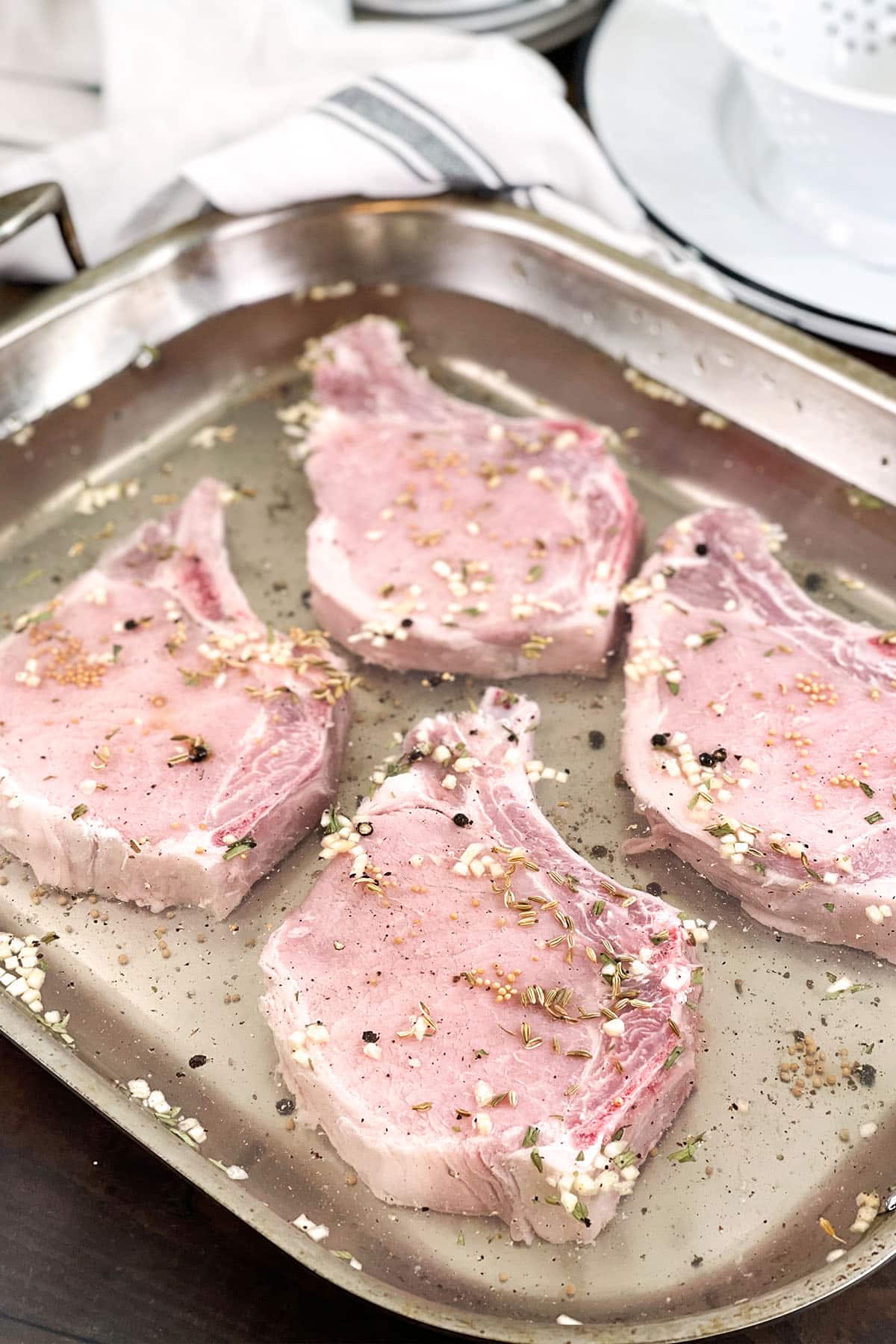
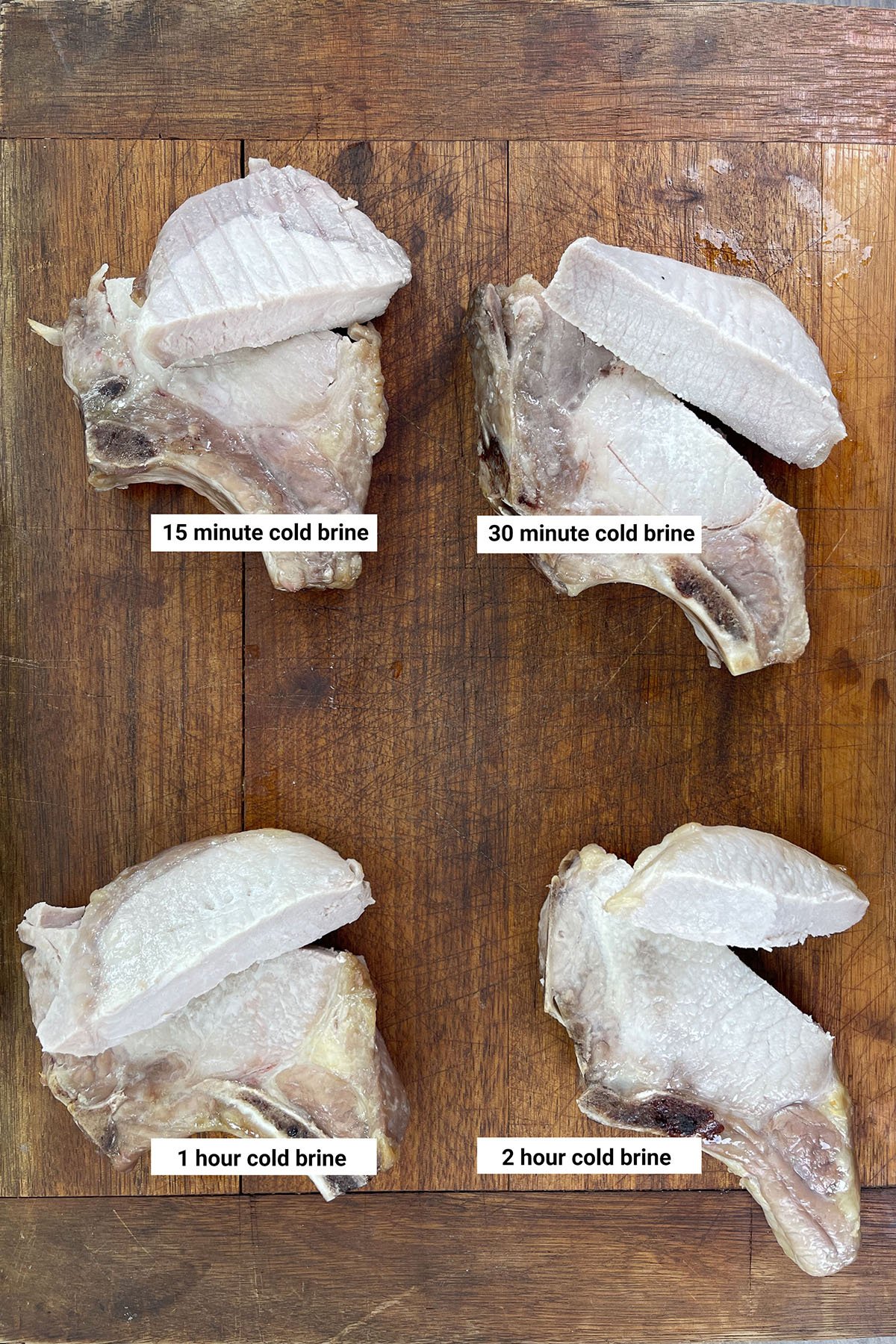

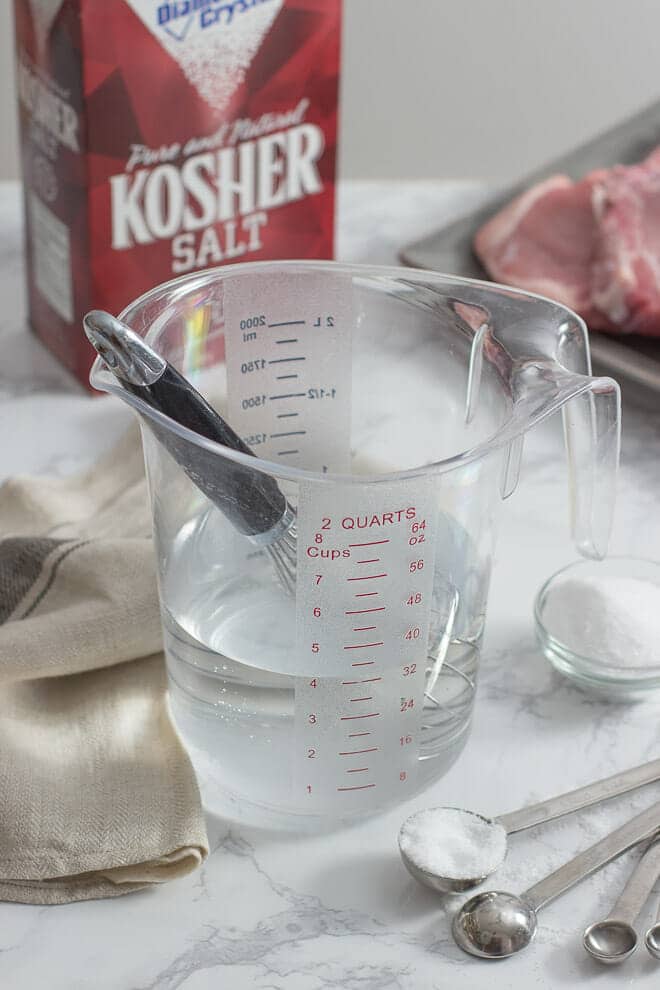
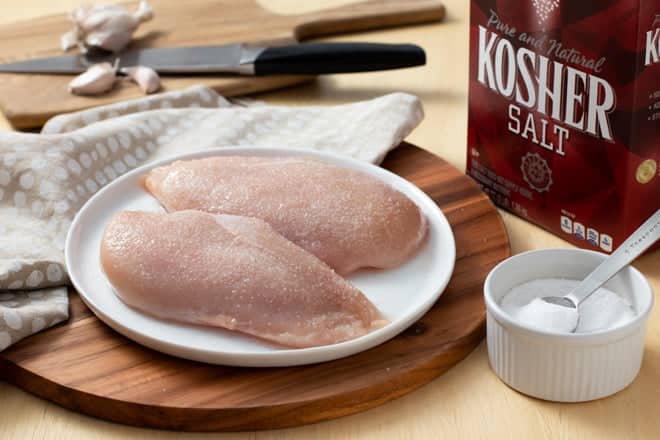
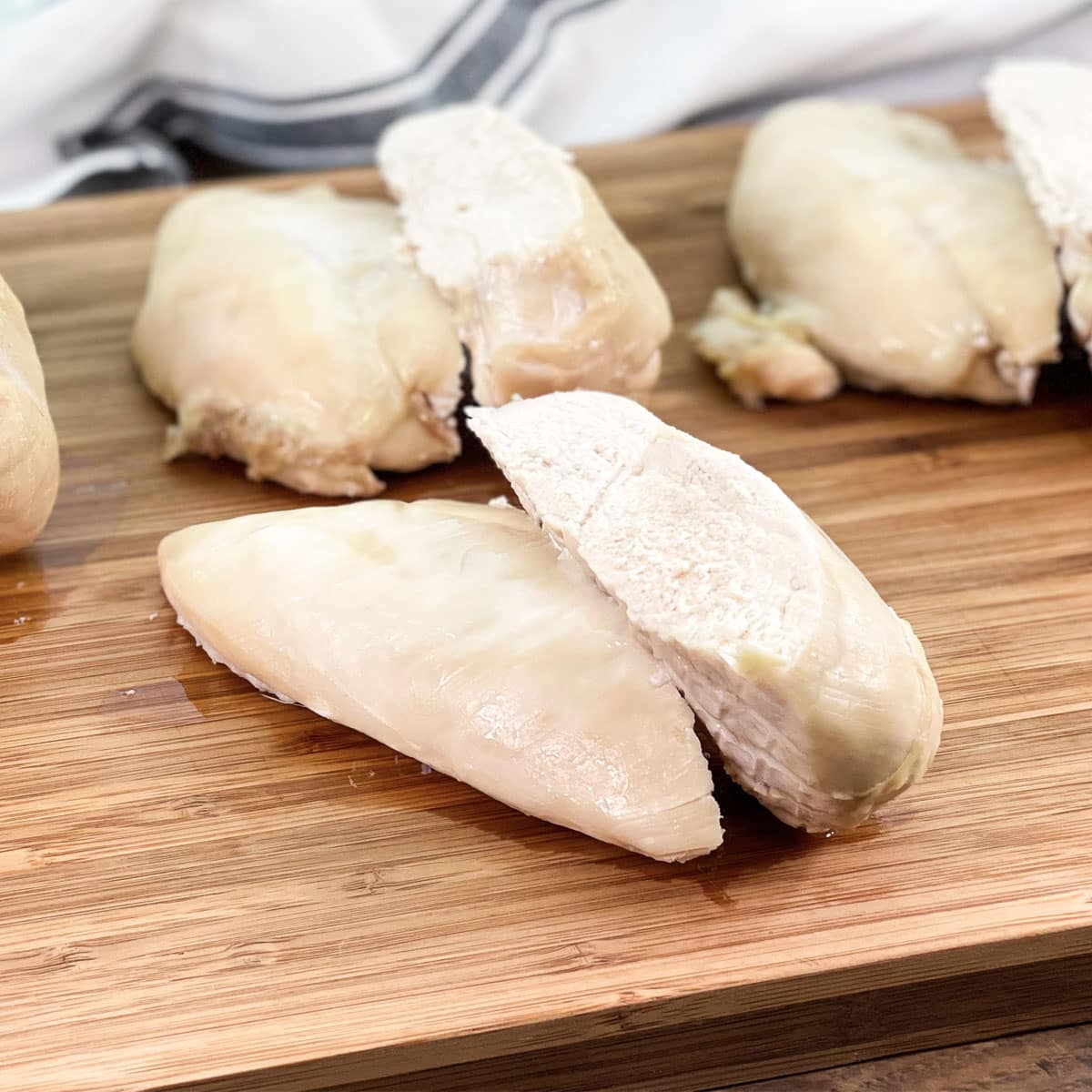
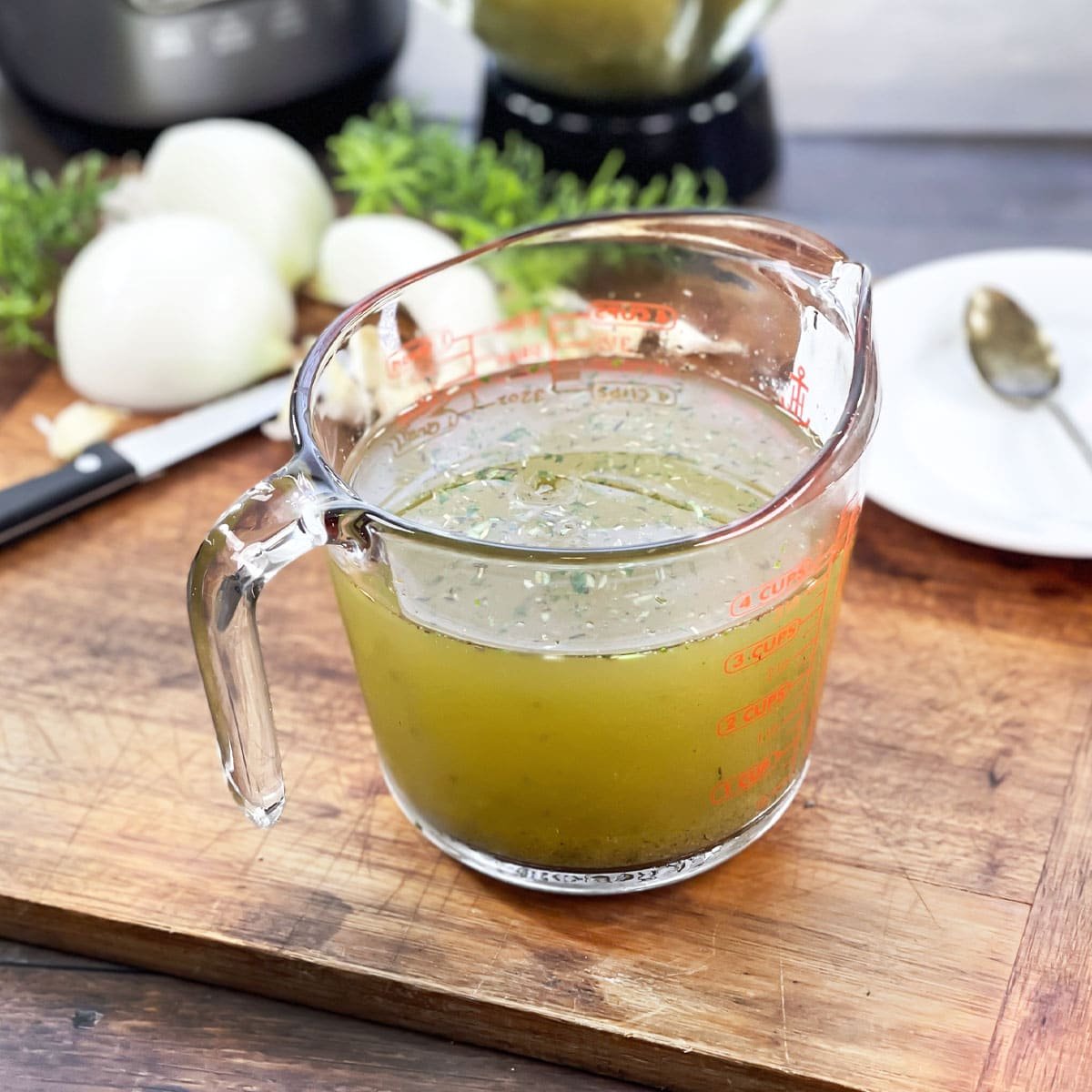



















I really appreciated your work on this. I’ve been brining for a while now, difference is now I understand how and why!
Couldn’t see stars to rate however I give it 6
Thank you so much, Jaime! The ability to leave star ratings has been acting up, but should be back to normal soon.
Tthe chicken came out awesome. I fried the chicken after brining. I was told it was the moistest, if that is a word, chicken ever that was fried. Oh and it was white meat chicken which is known for not being very moist. I even had a piece, which I never eat white meat chicken. Thank you. Now I am doing the same to the pork, very cheap cuts of pork. I just want to fry the pork (in black cast iron pan, i have had it since I was 25, I am now 77, yikes) after being coated in flour and that is all. Thanks again. Oh I never almost never follow a recipe, my taster is what I follow when I cook. :)
Diana, I’m so happy that you’re liking my recipes and that the white meat turned out so good. I’m like you and often dislike white chicken meat. But if it’s brined, it really is so much better!
Haven’t tried this yet but I’m happy to have this guide / especially concerning over brining
You’re going to love the results, Linda!
I had never tried brined pork chops before. Now I think this will probably be the best way to make them now. Thanks
You’re welcome, Novella! I’m glad you gave it a try.
I was wondering, if I’m doing a spiral pork loin roast, do you think I should brine before or after butterflying the loin flat?
Faith, you can do it either way. If you butterfly it first, then it won’t need very long in the brine. 1 hour will be enough.
If you do it before butterflying, it will need 3-4 hours like here: https://cookthestory.com/how-to-brine-pork-loin/ Note that I also think you should be cautious about using salt in the filling. It will likely get seasoned from the brine in the meat and so it probably doesn’t need very much.
Thanks for a great question!
Delicious and easy!
Thank you so much, Marcia!
This recipe totally upgrades a porkchop. I ended up with some thin cut porkchops because they were on sale at the store, I was looking for a good way to cook them (I usually have the thick ones). This totally helped me solve my problem.
I’m so glad this was helpful for you, Mara! Thanks for commenting.